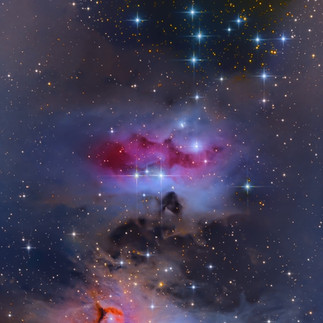Reviewing Skywatcher's 150/750 F5 Newtonian
- Katherine Miller
- May 22, 2022
- 4 min read
Updated: Dec 4, 2024
I began my astrophotography journey in 2020 when I purchased my first telescope, a Skywatcher Black Diamond 150/750 Newtonian. Which, until recently, I used exclusively for every session.
Over the past two years, this scope and I, have had our fair share of ups and downs, as most relationships do. But persevering through those challenges, I have come to love and respect this telescope for what it is, a budget friendly, kickass photon catcher!
'Skywatcher Black Diamond 150/750 Newtonian' is quite the mouthful, so instead, I will be referring to this telescope as the BD-150.
About the BD-150
The BD-150 has a relatively fast F5 aperture with a 150mm parabolic primary mirror and a versatile focal length of 750mm. It's light weight at 6 kilograms and has a 2-inch dual speed Crayford focuser. This scope currently retails for $650.00 as listed on Skywatcher Australia's website.
Included in the box with the telescope are:
a 28mm LET Eyepiece
8×50 Finder Scope
2 x 150mm Tube Rings
a Dovetail Bar.
Because the BD-150 is a Newtonian, I also purchased the Skywatcher F5 coma corrector and a laser collimator. Coma correctors are used to correct distortions in the optical path created by the mirrors. A laser collimator is a tool to align the primary and secondary mirrors. If you are looking at investing in a Newtonian telescope, it would be worth considering these tools to enhance your imaging.
After the first couple of successful sessions, remember, this was my first scope. So at the time, I was also learning polar alignment, camera settings and tracking. It took some months to get quality data. Some issues came to light.
First impression and issues discovered
Firstly and definitely, what grieved me the most was the diffraction spikes around my stars. I'm not talking about the beautiful pin point sharp spikes that make Newtonians famous. The diffraction spikes I had went in every direction and were completely uneven.
Here are some examples of uneven diffraction spikes I was experiencing:

I asked on a few forums and social media platforms about this issue, and most of the advice leant towards collimation. Yet no matter how well I collimated, the issue persisted. I was almost resigned to the fact that I would never get pinpoint diffraction spikes when I came across a forum post about this scope that talked about the mirror clips distorting the path of light causing irregular spikes on the stars. The original poster resolved the issue by 3D printing an aperture ring.
So I searched for the 3D printer file and asked my brother in law to print me one. The difference was mind blowing! Needless to say, I was one super duper happy Astrogirl.

I don't know why Skywatcher doesn't include this ring with the scope or as an accessory, a lot of research has shown that it affects this scope more than others. Due to the ring, I have lost some surface area of the primary mirror and as a result, there was a reduction to my focal length, a price I am willing to pay, as the difference is not even noticeable.
Another issue I had in the beginning, which was more user error, was the telescope not holding collimation. I would whip out the laser collimator every night and it would always be off centre. Again, I turned to google, it turns out the collimation springs were too loose. Luckily, this was an easy fix. Tightening the collimation bolts, tightened the tension on the springs and now the scope doesn't lose collimation as easy.
Lastly, I have found fault with the focuser/focusing tube. The BD-150 has a dual speed Crayford focuser that is smooth and I can achieve focus manually without any issue. But, on my scope, the focuser slips despite tightening the little bolts underneath to increase pressure. On top of that, I am not a fan of the fact there are only two small screws to hold the imaging train. I upgraded the locking mechanism to a compression ring which set me back about $50.00 AUD. Skywatcher use these compress ring locks on their refractor telescopes such as the Evolux, oddly they are not standard on all telescopes.
Why I love the BD-150
On a positive note, the image quality has far exceeded expectations. Now that I am more seasoned, my images are sharp with good contrast and details. The weather can disappoint, but I never doubt this telescope's ability to execute images well. Using this scope, two of my images have been awarded 'bronze' two years running in Skywatcher Australia's Astrophotographer of the Year awards!
Recent images I have taken using this telescope:
Using the BD-150 with the ZWO ASI533, I have found my field of view is perfect for most deep space targets.
This telescope doesn't just excel at nebula and other deep space objects. I have used this telescope for lunar and planetary imaging and visual observing. I admit I need a lot more experience imaging planets and look forward to planetary season this winter (2022).

However, visual observations are a real treat with the rings of Saturn and moons of Jupiter well defined, awing family and friends when I have the telescope set up during camping trips and backyard BBQs. I have had amazing results lucky imaging (stacking multiple video frames into a single image to overcome atmospheric distortion) on the lunar surface. When imaging with the ZWO ASI224 I can get up close and personal with lady lunar's craters. It blows my mind every time.
For all the issues I overcame with this scope, I can not fault the BD-150 for what it is, a budget friendly astrophotography/visual telescope for beginners. The BD-150 has a fast enough aperture for astrophotography, with a focal length that doesn't require me to be anal about guiding.
If you are starting your astronomy journey and contemplating what scope to choose, I recommend the BD-150. Despite the discussed issues, the results speak for themselves. I can't help but feel if the problems were more widely known, or I was more experienced, I probably wouldn't have suffered as I did with my stars and collimation because the fixes were easy enough. I've decided to review the BD-150 to help others make an informed decision when choosing their first scope and bring the issues I had to light.
If you are currently experiencing issues with stars on your BD-150 the 3D print file for the aperture ring is free to download.











Comments